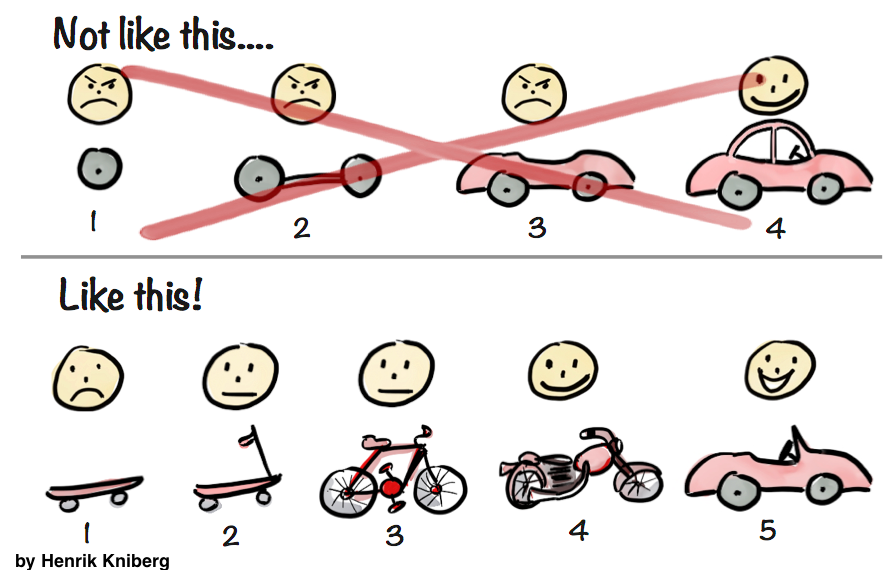Language is sometimes revealing. Traditional hierarchical organizations consist of functional divisions that divide areas of responsibility, divide power in terms of budget and headcount, and subdivide value creation. Divide et impera, divide and rule, is a time-tested maxim since the Roman Empire, the core of which is to encourage “divisions among the subjects to prevent alliances that could challenge the sovereign” (Wikipedia). The result is silos whose walls become thicker and thicker every year due to evaluation and incentive systems that are based on this maxim.
Think Big
Without tackling this structure and the underlying maxim, agility will silt up within these silos. The small agile project within a division will hardly make a big difference, because the division itself is only a tiny part of the value chain and therefore the feedback on the work of the division, which is so important for agility, is only available at the end of a long series of handovers.

A characteristic feature of true agility is to work across silo boundaries along the value chain in an interdisciplinary team. Hirotaka Takeuchi and Ikujiro Nonaka already identified this exact characteristic in 1986 in their research on successful product development teams and described it in their article “The New New Product Development Game” (Harvard Business Review).
In this sense, the agile transformation must therefore think big and break open silos in order to promote interdisciplinary cooperation, reduce handovers and ultimately shorten the feedback loop of experimentation and validation. Otherwise, the inconspicuous caterpillar will not turn into a beautiful butterfly, but rather into a somewhat more colorful caterpillar, disoriented and exhausted by the senseless theater of transformation.
Start Small
There are no blueprints for an agile organization and no master plan for transformation, no matter how convincing the promises of the respective consultants sound. The attempt to impose panaceas and seemingly proven models on one’s own organization leads straight to cargo cult hell. Not because the blueprints and models are fundamentally wrong or bad, but because they are not the result of shared experiences. Agile transformation is and remains a joint learning journey.
A journey of a thousand miles begins with a single step.
Laozi (Chapter 64 of the Dao De Jing)
Every organization must develop a suitable model step by step in the course of the agile transformation. An agile transformation cannot be conceived on the drawing board and then executed by legions of change managers. Instead, it develops itself in an agile manner from an initial Minimum Viable Product (MVP) through numerous intermediate stages, the value of which can ideally be proven with suitable key performance indicators.

The leadership task in agile transformation is not to select the best model of an agile organization or to design one of its own and then roll it out. This top-down approach violates the agile principle of self-organization because it degrades people and teams to passive objects of transformation, even though the goal is precisely autonomous, self-responsible and active subjects.
Learn Fast
If you want to spare your agile transformation this dead end, you are well advised to hang the role of the chess master on the hook and act more like a gardener. The goal must be to create a setting in which a suitable agile organizational model gradually emerges from the cooperation of self-organized teams. This joint learning process cannot be shortened by blueprints.
People don’t resist change – they resist being changed.
Peter Senge
However, learning can be accelerated through sharing and networking. Readily sharing experiences and knowledge, especially outside your own silo, is crucial. A program like Working Out Loud can help here, but the role model of leaders is crucial. As long as every manager continues to put his or her own business in order, there will be no fruitful exchange of ideas and information hiding and cover your ass will remain the norm.





